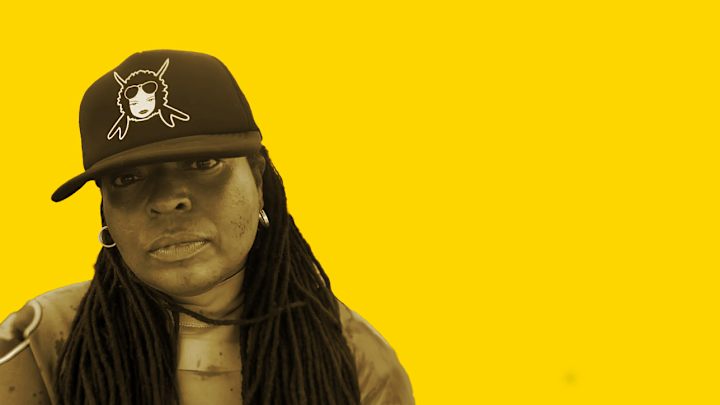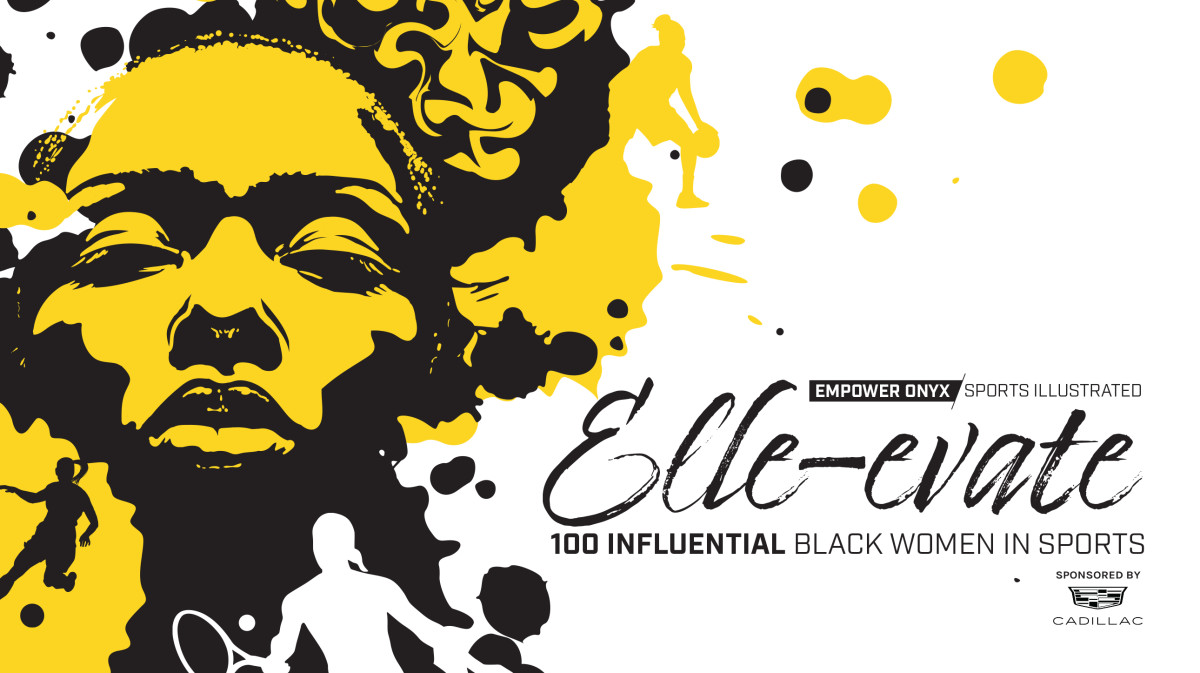Rhonda Harper Couples Social and Environmental Justice to Amplify Black Female Surfers


Sports Illustrated and Empower Onyx are putting the spotlight on the diverse journeys of Black women across sports—from the veteran athletes, to up-and-coming stars, coaches, executives and more—in the series, Elle-evate: 100 Influential Black Women in Sports.
When Rhonda Harper, founder and director of Black Girls Surf, used to sit with her siblings in her Kansas home watching a string of television shows, she had no idea that enjoying beach specials from her landlocked living room would lead to the most exhilarating sport of her life: surfing. When skateboarding took a backseat and the search for Black female wave riders began, Harper started to conceive an organization that affects much more than Black girls having the right to compete. Her roots, which run deep in social justice, continue to instill equity in the global surfing industry.
“In the 70s, Stevie Wonder, the NAACP, and civil rights were huge in Kansas City,” Harper says. “I was watching Muscle Beach Party and little Stevie Wonder made his debut. That was the connection for me.”
Harper adds that she began buying surfing magazines with money that she earned on her paper route. “There were no Black people surfing in the entire movie. The only time I saw somebody Black was when I saw Stevie perform. I already wanted to surf, but it wasn’t until I saw Stevie that I realized I could be in this scenario,” she says.
Harper’s family relocated to California when she was 10. They had a swimming pool in their backyard, a far cry from being turned away from the segregated pool two blocks from their former Kansas City home. “I learned how to swim in a Black community pool in Parkwood, three miles away from my house instead of the one that was just two blocks away,” says Harper. “My dad, who was a retired coast guard, taught me.”
When they arrived at their new home in San Jose, the pool water was green. So her mother took the family to the beach, and swimming became Harper’s sport until she graduated from high school. “I was probably the only senior with a graduating class ring that has a surfer on the side of it,” says Harper.
“I started out at 7, just watching the movies, and then I was transferred to San Jose, 20 minutes from the beach,” says Harper. “My whole life changed.” As the junior activist became a teenager, her social justice upbringing allowed little patience for inequity. Her rebellious spirit led to her parents sending her to live with her 19-year-old sister Natalie in Oahu, Hawaii. Harper is still amused when she recalls how they sent her away “for punishment.”
Her father nicknamed her “Rocky” because she was constantly fighting in school. “When I got to California, it was even worse because everybody was free with the mouth and it wasn’t segregated,” she says. Living with Natalie, a college student in Oahu, was heaven, as far as Harper was concerned. She stayed until she graduated from high school, and her adoration for the ocean and surfing brought her peace and clarity. The ocean was a mile away, and the bus was only 25 cents, Harper recalls.
“I learned a lot about myself,” she says. “First, I’m out there by myself. No lifeguards. It’s just me in the water. There’s a lot of anger that I brought in my suitcase about the reasons why I had to move. I could feel it leaving. A lightness came over me, as the days went by, and I was getting better and better. I just felt a lot calmer. There was a level of maturity that set in.” Harper’s sister told her not to get in the water without her. Nevertheless, caution was thrown to the waves. A determined Harper used to hide her $25 used board in thick brush next to the apartment, never bringing it inside. And her sister was never the wiser.
After graduation, Harper went to Fashion Institute of Design and Merchandising and worked with her older brother, Keith, who was already making clothes for Bobby Brown and New Edition. Harper’s celebrity client list grew and ranged from actor Eddie Murphy to rapper Heavy D.
After 25 years in the field, she decided to start her own surfing clothing line. All she needed was a Black surfer to model her clothes. That’s when she discovered how hard they were to find.
“I wanted an Afro-centric, surf-influenced clothing line for Black people who surf,” she says. While she was researching her niche market, she came across archival information on Inkwell Beach in Santa Monica, a place where Black people used to gather during segregation. “There was another article that I’d read about this first surfer of African and Latino descent, Nick Gabaldon, who surfed at that same beach.”
Harper began to connect her top passions—activism, surfing, fashion and writing—into one life-changing journey. After leading the charge to place a plaque memorial at Inkwell Beach in Santa Monica for Gabaldon, 24, whom Harper explains “was surfing on a big wave day, [when] he hit the pier in Malibu and died.” She continued to support and coach Black male surfers while searching for her female counterparts. It was important for them to have a space to showcase their athleticism. Harper’s quest would open the floodgates for women who had not been recognized in the world of surfing. Early on Harper experienced that feeling of exclusion.
“I tried out for the swim team in high school, but I didn’t look the same as my white counterparts did in their swimsuits,” she recalls. “So, I was always getting teased by the coach, who was already racist. He always had something to say about Black bodies and Black people. I told my mother I didn’t want to be around that environment. So, I quit.” Harper was grateful that surfing was an individual versus a team sport. And she said that she’d rather surf because it gave her a sense of peace.
The writing was truly on the wall when someone from a Black athlete sports network read Harper’s press release about Gabaldon’s plaque and asked her to report on Black surfers. “I started looking for a surfer, and I couldn’t find one that would fit into this category,” she says. “This is the beginning of me becoming a journalist so I can talk about why there aren’t any Black surfers. I had been getting magazines since I was 7 years old. Now, I'm in my 30s and I still don’t see any Black people on these pages.”
She completed a class with the International Surfing Association, which is part of the International Olympic Committee, and became the first Black judge for surfing. She decided to use this title to assemble a platform, The Africa Surf International, that lets Black surfers showcase their talent. The ASI was going to be a contest held in Sierra Leone for a specific reason: This was where African people were all separated and taken to different parts of the world, Harper explains. “I learned that they found surfing in Ghana before Hawaii,” she adds. “We were already surfing, but that information was kept from us.”
Years later, Harper realized something else that was hidden in plain sight: Afro-Latina surfers. She was “searching” for a wave-riding Black community, and it already existed. As her judging duties grew, she uncovered the mystery. “I found out that there are Black surfers all over the world,” she says. “Some of them weren’t identifying, because it was the early 2000s and we weren’t calling people who lived in Venezuela and Brazil Afro-Latina or Afro-Brazilian yet. I was seeing these surfers while I was a reporter, and I missed it.”
“There was literally a Black woman surfer, Suelen Naraísa, who carried the Olympic torch in 2016,” she says. “When I speak about culture and Black people in surfing, I cannot leave out the Brazilian community because they’ve had it built up for a very long time.” The discovery inspired Harper to continue her fight.
She went to International Surfing Association games in 2005 and ’06, where she noticed the absence of Black women competing. Finally, Harper found enough girls to assemble a heat. In 2014, she encouraged her team to do an exhibition that would allow the girls “to go out and win trophies.” And Harper hoped that “maybe this would spark a new generation of people seeing Black women surfing.”
Then Ebola hit the country and put the ASI contest on hold. That’s when Harper decided to bring two of the girls from West Africa to California for training and “the proper” exposure. (One ended up not coming to the states due to the travel ban and embassy closures). Over the following years, Black Girls Surf began to take form. “Even though everything was shutting down I kept working on getting exposure for Black women,” says Harper. She could never have seen what was coming next: COVID-19, which stranded Harper in Senegal for two years.
“Everything that you see about Black Girls Surf now was done from an apartment in Senegal because I was trapped,” says Harper, who planned a quick trip back to the country to film Khadjou Sambe, the Senegalese surfer she’s training for the Olympics and the pro World Surf League. “I was there two years when the country closed. I couldn’t come home.” Yet, her social justice morphed and thrived through the pandemic. “I trained girls in Senegal,” she says. “We don’t speak the same language. I don’t know Wolof. I don’t know French. But I know direction, compassion and empathy.”
According to Harper, Sambe’s surfing journey will eventually change the Senegalese Federation. “The Senegal girls are not registered with their federation,” says Harper. “They did not want Black Girls Surf to be in that federation because they know this is going to change the country. It’s already shifting,” says Harper, who did a worldwide paddle out for George Floyd.
“The surfing industry was so locked into environmental justice that they didn’t realize it goes hand in hand with social justice,” she says. “We know that because there’s landfills in Black and brown communities. This is not just about the ocean. It’s about the environment and its totality. I was watching my white counterparts talk about whales being killed. And on the other side, all my Black friends were crying because Black people are being killed.”
Her unwavering activism continues to push boundaries as she moves the needle on her Black Girls Surf mission with unique programs like surfing therapy; GROMS, an NFT collection; surfing camps, like the one at Bowdoin College in Maine; and of course her clothing line, Hurley Black Girls Surf.

Bryna Jean-Marie is a contributor for Empower Onyx, a diverse multi-channel platform celebrating the stories and transformative power of sports for Black women and girls.
